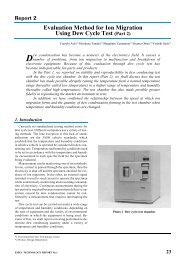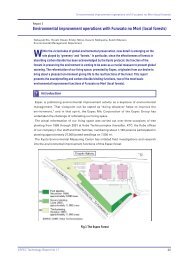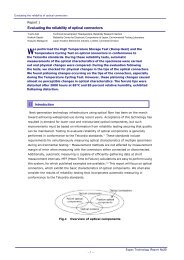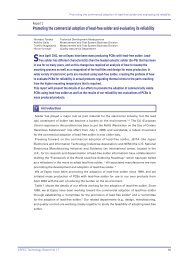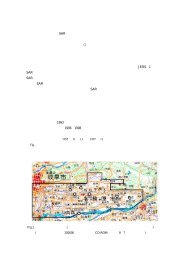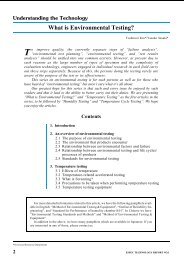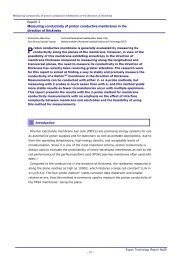download
download
download
You also want an ePaper? Increase the reach of your titles
YUMPU automatically turns print PDFs into web optimized ePapers that Google loves.
Measuring Conductivity of Proton Conductive Membrane in the direction of thickness, partⅡ:<br />
using the 4-probe method in the direction of thickness<br />
Fig.3 demonstrates that the impedance pertaining to the electric current lead-in membrane and<br />
its interfaces with electric current lead-in electrodes, RmCE, RmWE, and RctCE, RctWE, CdlCE, CdlWE, are<br />
situated outside the electric potential sampling measurement system, and thus have little<br />
influence on measurement results. As a result, bulk membrane resistance Rm can be measured<br />
accurately using this method, provided the impedance related with RctRE1, RctRE2, and CdlRE1, CdlRE2 are small enough. This impedance can be reduced by adjusting hot-pressing conditions and<br />
manufacturing processes of MEA specimens. Hence, we may infer that the electric current lead-in<br />
electrodes, CE and WE, may be omitted by substituting two electrode terminals of the measuring<br />
cell. Also, the electric current lead-in membranes of CE and WE do not affect the results even if<br />
different kinds and/or thickness of membranes are used, although they should possess the same<br />
current-conducting carriers as the test membrane, viz., either electron, proton, or other ions. In<br />
addition, test membranes can be pretreated by hot-pressing at various pressures and<br />
temperatures, or any chemical treatments may be applied before preparing MEA specimens.<br />
Thus, this method allows a wide range of membrane conditions.<br />
However, it is necessary to prevent the thickness and the evenness of test membranes from<br />
being affected when the test membrane is combined into an MEA specimen. This means that<br />
temperature and pressure conditions must be neither too high nor too low when hot-pressing for<br />
successfully preparing MEA specimens. In this report, we have reported a two-step method by<br />
which reference electrodes were completely imbedded into electric current lead-in membranes in<br />
the first step. Because of this, we were able to use fairly reduced temperature and pressure<br />
conditions without markedly disturbing test membranes in the following second step.<br />
Consequently, the accuracy, reliability and reproducibility of the ion conductivity measurements<br />
using the 4-probe method in the direction of thickness have been significantly enhanced.<br />
3-2 Identifying cause of failure of MEA specimens from O/L error messages in<br />
electrochemical measurement<br />
When using the impedance gain/phase analyzer and electrochemical interface measuring<br />
system of Solartron Instruments to measure the proton conductivity in the direction of thickness<br />
of polymeric electrolyte membrane using the 4-probe method, RE1 O/L, RE1-RE2 O/L, and<br />
Current O/L and Current DVM O/L errors frequently occurred on the Potentiostat/Galvanostat<br />
electrochemical device (Model 1287, electrochemical interface). 6) These messages, combined<br />
with the measuring principle of the electrochemical device used, may work as an informative<br />
guide for determining the failure cause of the MEA specimen, i.e., what defects have been<br />
observed and/or what failures have developed when measuring MEA specimens. For example,<br />
the appropriate conditions for the manufacture and measurement of MEA specimens can be<br />
found more effectively and rapidly based on analyses of these errors.<br />
- 8 -<br />
Espec Technology Report No.23



